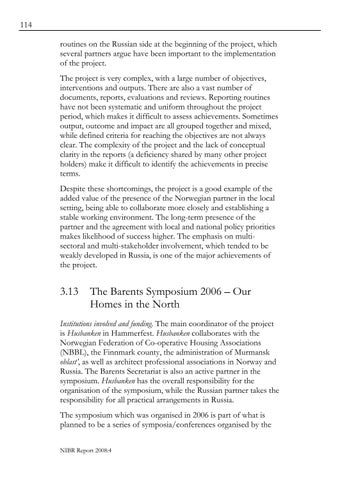114 routines on the Russian side at the beginning of the project, which several partners argue have been important to the implementation of the project. The project is very complex, with a large number of objectives, interventions and outputs. There are also a vast number of documents, reports, evaluations and reviews. Reporting routines have not been systematic and uniform throughout the project period, which makes it difficult to assess achievements. Sometimes output, outcome and impact are all grouped together and mixed, while defined criteria for reaching the objectives are not always clear. The complexity of the project and the lack of conceptual clarity in the reports (a deficiency shared by many other project holders) make it difficult to identify the achievements in precise terms. Despite these shortcomings, the project is a good example of the added value of the presence of the Norwegian partner in the local setting, being able to collaborate more closely and establishing a stable working environment. The long-term presence of the partner and the agreement with local and national policy priorities makes likelihood of success higher. The emphasis on multisectoral and multi-stakeholder involvement, which tended to be weakly developed in Russia, is one of the major achievements of the project.
3.13
The Barents Symposium 2006 – Our Homes in the North
Institutions involved and funding. The main coordinator of the project is Husbanken in Hammerfest. Husbanken collaborates with the Norwegian Federation of Co-operative Housing Associations (NBBL), the Finnmark county, the administration of Murmansk oblast’, as well as architect professional associations in Norway and Russia. The Barents Secretariat is also an active partner in the symposium. Husbanken has the overall responsibility for the organisation of the symposium, while the Russian partner takes the responsibility for all practical arrangements in Russia. The symposium which was organised in 2006 is part of what is planned to be a series of symposia/conferences organised by the NIBR Report 2008:4

